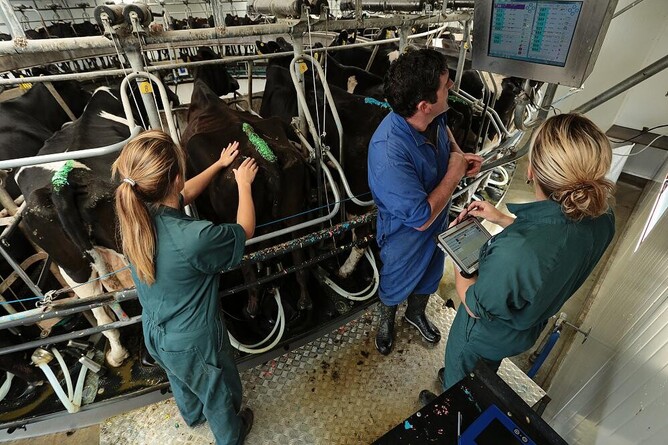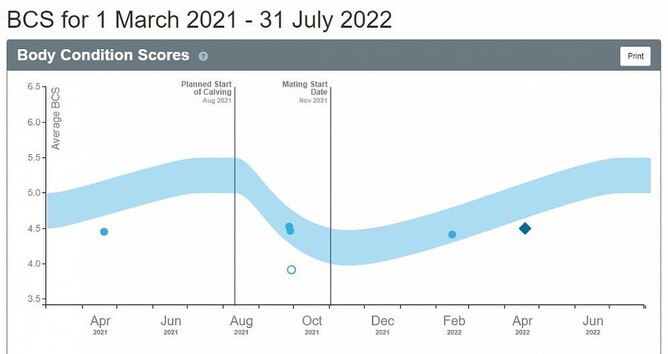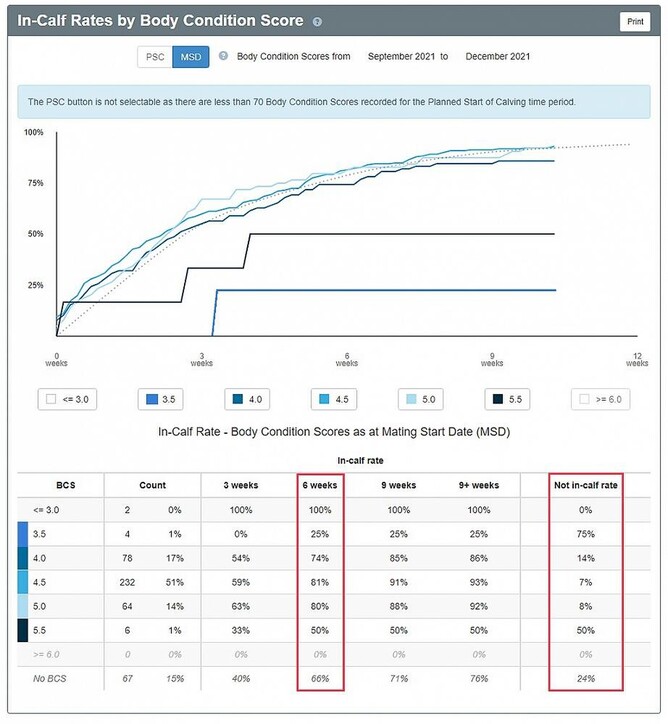Body condition scoring (BCS) is a tool to help assess and quantify an animal's body reserves or accumulation of fat. Assessing changes in BCS over a time period is a reliable measure of the nutritional status of an animal. Minimising body condition loss between calving and mating and having animals at target BCS has been shown to enhance reproductive parameters including increased 6 week in-calf rates.
DairyNZ provides some targets for BCS at calving to optimise reproductive performance:
- 5.0 for mature animals
- 5.5 for heifers and second calvers
- The aim is to have less than 15% of the herd above or below these scores
- In early lactation losses of up to 1.0 BCS can be expected, meaning cows at target for calving will likely be BCS 4.0-4.5 for mating
- The target is no more than 0.5 loss in early lactation, which would mean cows at higher condition of 4.5-5.0 for mating.
These losses can be partly attributed to the energy required for lactation exceeding energy provided by dietary intake or Negative Energy Balance (NEB). It is normal for cows to be in NEB for a period after calving (6-8 weeks), but it is important they are in positive energy status and have stopped losing condition prior to mating.
In the first month after calving, there is little that can be done to stop BCS loss. The most important factor to reduce loss over this time is feed management in the dry period. For those animals that are below target BCS coming into mating, DairyNZ suggests the following:
- Identify cows and heifers below target
- Consider milking once daily while ensuring sufficient dietary intake - reducing energy demands. This aids the transition to the milking diet and improves the rate of rumen recovery post-calving
- If animals are still milking twice daily, separate any thinner, younger animals from the main mob. Give preferential feeding with good quality pasture and supplements if required. This will reduce competition and improve energy status.
A useful way to assess the suitability of animals for twice-daily milking is to look at animals from behind, at the start of milking, to assess body shape. If the rumen/belly on the animal's left side is wider than the udder (apple shape), she is likely eating enough (sufficient rumen fill) to adapt to being milked twice daily. If the rumen is not wider than the udder (pear shape) then she should be kept on once daily for a bit longer.
Cows calving in lower BCS, 4.0-4.5, may lose less condition by mating time but experience a delay in starting cycling, reproductive performance decreases and a drop in milk solid production - can be up to 17kgMS per cow less (per lactation). On the other end of the spectrum, cows calving in too high a BCS, over 5.5, at calving are likely to lose excess condition post-calving (often up to BCS 1.5) and experience reduced reproductive performance.
Heifers are more susceptible to losing over 1.0 BCS. Calving them a bit early and prioritising their feeding can mitigate this and allow you to minimise condition loss and maximise their chances of getting in calf early. Prioritised feeding can be running them in a separate herd if feasible.
Cows and heifers at target, or 0.5 above target, BCS for mating have a higher 6 week in-calf rate and lower empty rate (LIC).
Improving reproductive outcomes
Through MINDA Live we are able to assess BCS in relation to reproductive performance. Data from a client of VetSouth, who regularly body condition scores through the WelFarm programme, demonstrates the benefit of having animals at target BCS for calving and mating.
The below chart shows the average BCS of animals in the herd over several months. The decrease in BCS after calving and prior to mating can be seen. The blue band represents the range within most of the animals’ score, which sits between 4.0 and 4.5 at planned mating time.
This next chart compares data between BCS at the start of mating and in-calf rates at 3-week intervals and the not-in-calf rate (empty rate) for each score for the Spring 2021 period. Cows at target BCS for the start of planned mating (4.5-5.0) had better reproductive outcomes. The animals with both the highest 6-week in-calf rate and the lowest empty rate are those at 4.5 and 5.0 BCS. Those at BCS 4.0 do well but have a higher empty rate, while animals at BCS 3.5 and 5.5 underperform.
Condition scoring at mating is really important to reproductive outcomes. The condition at this time is hugely dependent on BCS at calving and on minimising the loss between calving and mating. If you have queries regarding body condition scoring for your herd please contact the practice to speak to one of the team.
- Zoe Hebblethwaite



